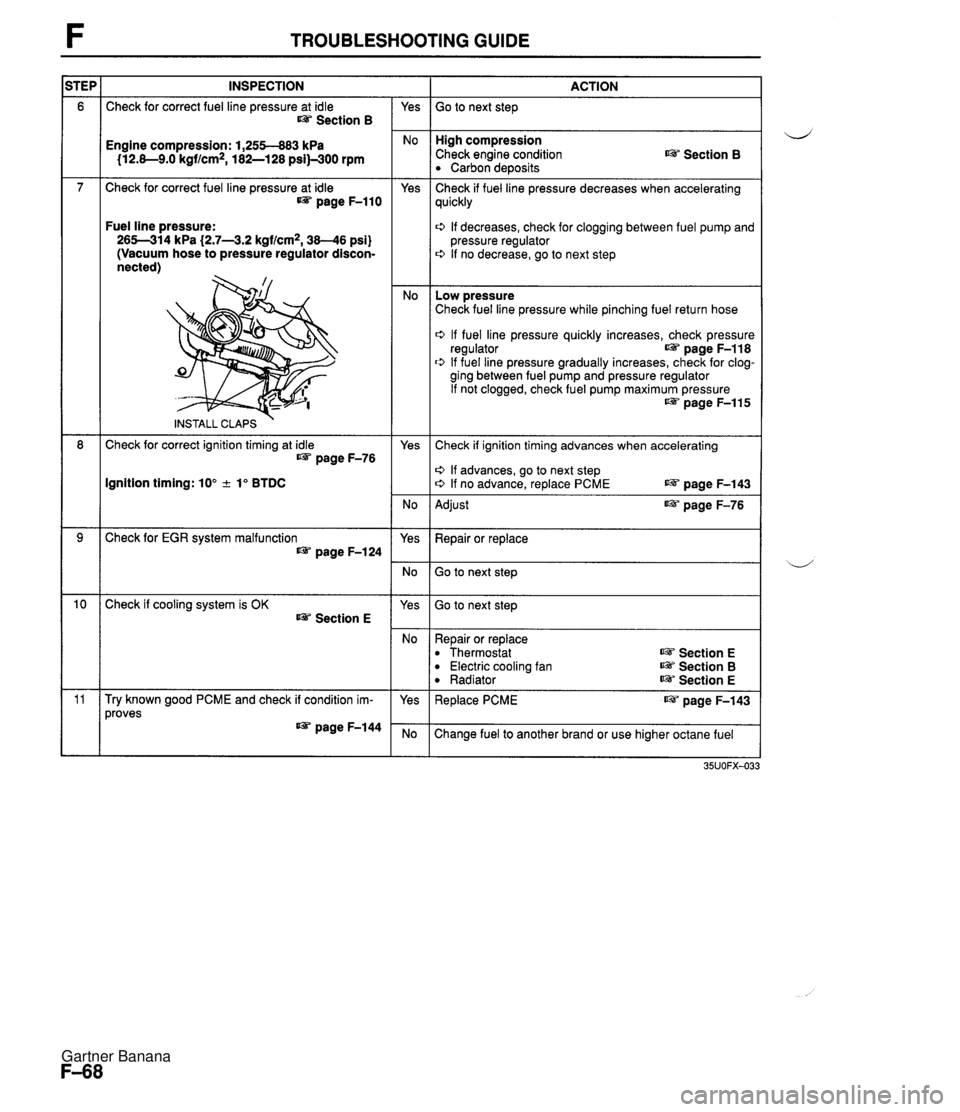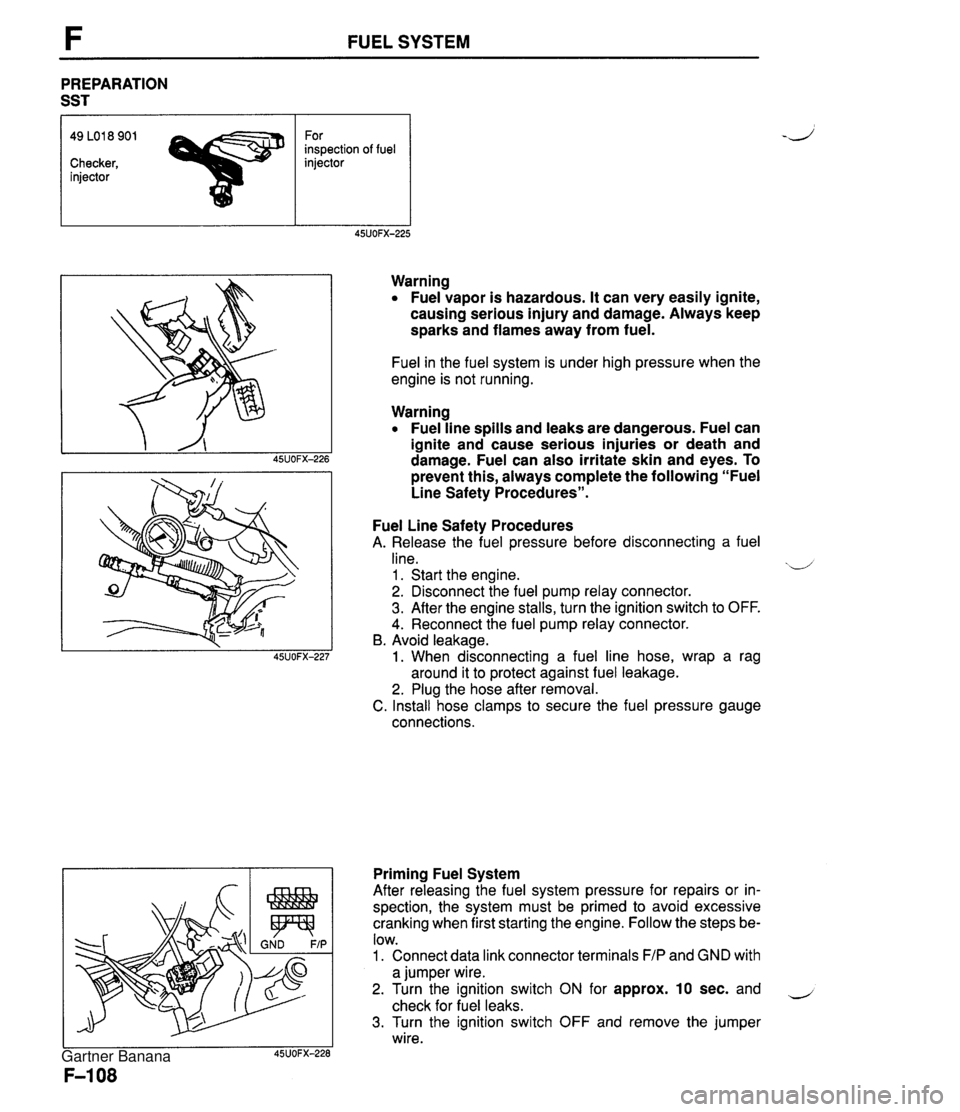1994 MAZDA MX-5 fuel pump
[x] Cancel search: fuel pumpPage 205 of 1708

F TROUBLESHOOTING GUIDE INSPECTION ACTION Check if throttle linkage is correctly installed and operates freely Yes Go to next step Correct, clean, or replace as required any binding or dam- aged linkage and adjust cable deflection at throttle body r@ page F-103 Check for correct intake manifold vacuum at idle Vacuum: More than 450 mmHg I17.7 inHg) VACUUM GAUGE / Yes Go to next step No - Yes Check for air leakage of intake air system components r@ page F-100 Go to next step Check if air cleaner element is clean page F-76 Replace air cleaner element page F-99 Check for correct ignition timing at idle page F-76 Yes - No Check if ignition timing advances when accelerating .I, If advances, go to next step o If no advance, replace PCME page F-143 Adjust r@ page M6 Ignition timing: 10" -r- lo BTDC Check for correct fuel line pressure at idle page F-110 Yes Check if fuel line pressure decreases when accelerating quickly Fuel line pressure: 265-314 kPa (2.7-3.2 kgf/cm2, 38-46 psi) (Vacuum hose to pressure regulator discon- nected) o If decreases, check fuel line and filter for clogging 0 If no decrease, go to next step No - Yes Low pressure Check fuel line pressure while pinching fuel return hose 0 If fuel line pressure quickly increases, check pressure regulator page F-113 0 If fuel line pressure gradually increases, check for clog- ging between fuel pump and pressure regulator If not clogged, check fuel pump maximum pressure page F-115 INSTALL CLAPS Repair or replace Check for EGR system malfunction page F-124 No - Yes - No Go to next step - -- Check if exhaust system is restricted page F-128 -- - Repair or replace So to next step Try known good PCME and check if condition im- 3roves page F-144 Gartner Banana
Page 208 of 1708

TROUBLESHOOTING GUIDE INSPECTION ACTION :heck for correct intake manifold vacuum at idle Iacuum: More than 450 mmHg i17.7 inHg} VACUUM GAUGE / :heck if air cleaner element is clean page F-76 Check for fuel injector operating sound at idle Check if battery positive voltage exists at fuel injec- tor connector B terminal Check if PCME terminal voltages are OK (1 R, 1 T, 2D, 20 and 2Q) page F-146 Check for correct fuel line pressure at idle page F-110 Fuel line pressure: 265--314 kPa i2.7-3.2 kgf/cm2, 38-46 psi) (Vacuum hose to pressure regulator discon- nected) INSTALL CLAPS Yes - No Yes - No - Yes No - Yes Yes No - Yes - No Go to next step -- - --- Check for air leakage of intake air system components r@= page F-100 Go to next step Replace air cleaner element ~8 page F-99 Go to Step 14 Go to Step 13 check if fuel injector resistance is OK page F-119 Resistance: 12-16R 6 If OK, check wiring between PCME and fuel injector E+Y page F-7 6 If not OK, check fuel injector for fuel leakage page F-120 Check wiring between PCME and fuel injector page F-7 Go to next step Check for cause (Refer to "Check Point for Each Termi- nal") page F-148 Check if fuel line pressure decreases when accelerating quickly c:, If decreases, check fuel pump maximum pressure @r page F-115 If OK, check fuel line and filter for clogging o If no decreases, go to next step Low pressure Check fuel line pressure while pinching fuel return hose ~2 If fuel line pressure quickly increases, check pressure regulator I@= page F-118 o If fuel line pressure gradually increases, check for clog- ging between fuel pump and pressure regulator r@= page F-119 If not clogged, check fuel pump maximum pressure page F-115 Gartner Banana
Page 212 of 1708

TROUBLESHOOTING GUIDE INSPECTION Sheck if air cleaner element is clean page F-76 1 :: :heck for EGR system malfunction Yes page F-124 Check for fuel injector operating sound at idle Yes Check if battery positive voltage exists at fuel injec- Yes tor connector B terminal Check if PCME terminal voltages are OK [I B, 1 T, 2D, 20 and 2Q) Check for correct fuel line pressure at idle Yes @T page F-110 Fuel line pressure: 265-314 kPa (2.7--3.2 kgf/cm2, 38--46 psi} (Vacuum hose to pressure regulator discon- nected) i INSTALL CLAPS I ACTION Go to next step Replace air cleaner element G= page F-99 Repair or replace Go to next step Go to Step 15 Go to Step 14 Check if fuel injector resistance is OK ccsf page F-119 Resistance: Approx. 12-16R - 0 If OK, check wiring between PCME and fuel injector a? page F-7 O If not OK, check fuel injector for fuel leakage page F-120 Check wiring between PCME and fuel injector ccsf page F-7 Go to next step Check for cause (Refer to "Check Point for Each Termi- nal") mzf page F-148 Check if fuel line pressure decreases when accelerating quickly O If decreases, check fuel pump maximum pressure page F-115 If OK, check fuel line and filter for clogging O If no decreases, go to next step Low pressure Check fuel line pressure while pinching fuel return hose 13 If fuel line pressure quickly increases, check pressure regulator mzf page F-118 6 If fuel line pressure gradually increases, check for clog- ging between fuel pump and pressure regulator If not clogged, check fuel pump maximum pressure @ page F-115 Gartner Banana
Page 217 of 1708

TROUBLESHOOTING GUIDE INSPECTION Check for correct fuel line pressure at idle Section B ACTION Go to next step - Yes High compression Check engine condition Carbon deposits Engine compression: 1,255-883 kPa 112.8-9.0 kgf/cm2, 182-128 psi)-300 rpm Section B Check for correct fuel line pressure at idle page F-110 Yes - No Check if fuel line pressure decreases when accelerating quickly Fuel line pressure: 265-314 kPa (2.7-43.2 kgf/cm2, 38-46 psi) (Vacuum hose to pressure regulator discon- nected) 0 If decreases, check for clogging between fuel pump and pressure regulator 0 If no decrease, go to next step Low pressure Check fuel line pressure while pinching fuel return hose 0 If fuel line pressure quickly increases, check pressure regulator page F-118 0 If fuel line pressure gradually increases, check for clog- ging between fuel pump and pressure regulator If not clogged, check fuel pump maximum pressure w page F-115 INSTALL CLAPS Check for correct ignition timing at idle IJ&T page F-76 Yes Check if ignition timing advances when accelerating o If advances, go to next step o If no advance, replace PCME LW page F-143 Ignition timing: 10" + lo BTDC No - Yes Adjust page F-76 Check for EGR system malfunction page F-124 Repair or replace Go to next step Go to next step Check if cooling system is OK Section E Yes No - Yes Repair or replace Thermostat Electric cooling fan Radiator ~3 Section E Section B Section E Try known good PCME and check if condition im- proves IJ&T page F-144 Replace PCME page F-143 Change fuel to another brand or use higher octane fuel Gartner Banana
Page 247 of 1708

INTAKE AIR SYSTEM INTAKE AIR SYSTEM COMPONENTS Removal 1 Inspection l Installation Warning Fuel vapor is hazardous. It can very easily ignite, causing serious injury and damage. Always keep sparks and flames away from fuel. Fuel in the fuel system is under high pressure when the engine is not running. Warning Fuel line spills and leaks are dangerous. Fuel can ignite and cause serious injuries or death and damage. Fuel can also irritate skin and eyes. To prevent this, always complete the follow- ing "Fuel Line Safety Procedures". Fuel Line Safety Procedures A. Release the fuel pressure before disconnecting a fuel line. 1. Start the engine. 2. Remove the fuel pump relay. 3. After the engine stalls, turn the ignition switch to OFF. 4. lnstall the fuel pump relay. B. Avoid leakage. 1. When disconnecting a fuel line hose, wrap a rag around it to protect against fuel leakage. 2. Plug the hose after removal. C. lnstall hose clamps to secure the fuel pressure gauge connections. 1. Drain the engine coolant. (Refer to section E.) 2. Remove in the order shown in the figure. 3. Check the components for damage and repair or replace as necessary. 4. lnstall in the reverse order of removal, using new gaskets. 5. Refill the engine coolant. (Refer to section E.) Gartner Banana
Page 256 of 1708

FUEL SYSTEM F FUEL SYSTEM DESCRIPTION . This system supplies the necessary fuel for combustion at a constant pressure to the fuel injectors. Fuel is metered and injected into the intake manifold according to the injection control signals from the power- train control module (engine). The system consists of the fuel tank, the fuel pump, the fuel filters, the fuel distributor, the pressure regulator, the fuel injectors, and the fuel pump relay. I I 1. Fuel tank 5. Fuel pump relay Removal / Inspection / Inspection .................. page F-117 Installation ................ page F-111 Replacement ............... page F-117 2. Fuel filter 6. Pressure regulator Replacement ............... page F-113 Inspection .................. page F-118 3. Fuel pump Replacement ............... page F-119 .................. w Inspection page F-114 7. Fuel injector Replacement ............... page F-115 Inspection .................. page F-119 4. Fuel distributor Removal ................... page F-119 Installation ................. page F-121 Gartner Banana
Page 257 of 1708

FUEL SYSTEM PREPARATION SST 49 LO1 8 901 For inspection of fuel Checker, injector injector Warning Fuel vapor is hazardous. It can very easily ignite, causing serious injury and damage. Always keep sparks and flames away from fuel. Fuel in the fuel system is under high pressure when the engine is not running. Warning Fuel line spills and leaks are dangerous. Fuel can ignite and cause serious injuries or death and damage. Fuel can also irritate skin and eyes. To prevent this, always complete the following "Fuel Line Safety Procedures". Fuel Line Safety Procedures A. Release the fuel pressure before disconnecting a fuel line. xd 1 . Start the engine. 2. Disconnect the fuel pump relay connector. 3. After the engine stalls, turn the ignition switch to OFF. 4. Reconnect the fuel pump relay connector. B. Avoid leakage. 1. When disconnecting a fuel line hose, wrap a rag around it to protect against fuel leakage. 2. Plug the hose after removal. C. Install hose clamps to secure the fuel pressure gauge connections. Priming Fuel System After releasing the fuel system pressure for repairs or in- spection, the system must be primed to avoid excessive cranking when first starting the engine. Follow the steps be- low. 1. Connect data link connector terminals F/P and GND with a jumper wire. 2. Turn the ignition switch ON for approx. 10 sec. and - check for fuel leaks. 3. Turn the ignition switch OFF and remove the jumper wire. Gartner Banana
Page 258 of 1708

FUEL SYSTEM SYSTEM OPERATION Fuel Pressure Hold Inspection Warning Fuel line spills and leaks are dangerous. Fuel can ignite and cause serious injuries or death and damage. Fuel can also irritate skin and eyes. To prevent this, always complete the "Fuel Line Safety Procedures" on page F-108. 1. Disconnect the negative battery terminal. 2. Install a fuel pressure gauge between the fuel pipe and the fuel main hose. (Install clamps as shown.) 3. Connect the negative battery terminal. 4. Connect data link connector terminals F/P and GND with a jumper wire. 5. Turn the ignition switch ON for 10 sec. to operate the fuel Pump. 6. Turn the ignition switch OFF and disconnect the jumper wire. 7. Observe the fuel pressure after 5 min. Fuel pressure: More than 147 kPa (1.5 kgf/cm2, 21 psi) 8. If not as specified, perform the following inspections. Fuel pump hold pressure (Refer to page F-114.) Pressure regulator hold pressure (Refer to page F-118.) Fuel injector fuel leakage (Refer to page F-120.) Gartner Banana